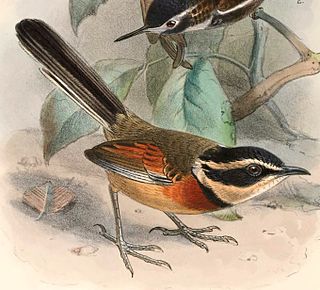
The amethyst-throated sunangel is a species of hummingbird in the "coquettes", tribe Lesbiini of subfamily Lesbiinae. It is found in Bolivia, Ecuador, and Peru.

The Andean potoo is a species of bird in the family Nyctibiidae. It is found in Bolivia, Colombia, Ecuador, Peru, and Venezuela.

The rusty-belted tapaculo, Liosceles thoracicus, is a species of bird in the family Rhinocryptidae. It is found in Brazil, Bolivia, Colombia, Ecuador, and Peru.

The elegant crescentchest is a species of bird in the family Melanopareiidae. It is found in Ecuador and Peru.

The crescentchests are a genus, Melanopareia, of birds from South America. The genus has long been placed with the tapaculos in the family Rhinocryptidae. Their placement there has been questioned and in 2007 the genus was placed in its own family, Melanopareiidae, by the South American Classification Committee. Subsequently, the family was accepted by the International Ornithological Congress Bird List and the Clements Checklist. The family Melanopareiidae was formally erected in 2009.

The olive-crowned crescentchest is a species of bird in the family Melanopareiidae. It is found in Argentina, Bolivia, and Paraguay.

The collared crescentchest is a species of bird in the family Melanopareiidae. It is found in Brazil and Paraguay.

The neblina tapaculo is a species of bird in the family Rhinocryptidae. It is endemic to the Andes of northern Peru.

The Paramo tapaculo is a species of bird in the family Rhinocryptidae. It is found in the Andes of Ecuador and southern Colombia.

The Caracas tapaculo is a species of bird in the family Rhinocryptidae. It is endemic to Venezuela.

The Chocó tapaculo is a species of bird in the family Rhinocryptidae. It is found in Colombia, Ecuador, and Panama.

The rufous-vented tapaculo is a species of bird in the family Rhinocryptidae. It is endemic to Peru.

The Mérida tapaculo is a species of bird in the family Rhinocryptidae. It is endemic to Venezuela.

This species is at risk of endangerment. One reason being that the protocols to protect these animals does not protect them entirely. The issue of endangerment is mostly due to the fact that the sole protected area only covers forests below 600m and the bird is above on elevation rate.

The Santa Marta tapaculo is a species of bird in the family Rhinocryptidae. It is endemic to the Sierra Nevada de Santa Marta of Colombia.

The puna tapaculo is a species of bird in the family Rhinocryptidae. It is found in Bolivia and Peru.

The Vilcabamba tapaculo is a small passerine bird in the family Rhinocryptidae. It is endemic to Peru.

The double-collared crescentchest is a species of bird in the family Melanopareiidae. It is found in eastern Bolivia.

The Ampay tapaculo is a species of bird in the family Rhinocryptidae. It is endemic to Peru.

The Loja tapaculo is a species of bird in the family Rhinocryptidae that the South American Classification Committee of the American Ornithological Society (AOS) accepted as a new species in July 2020. It had been classified as a subspecies of paramo tapaculo. It is found in Ecuador and Peru.




















